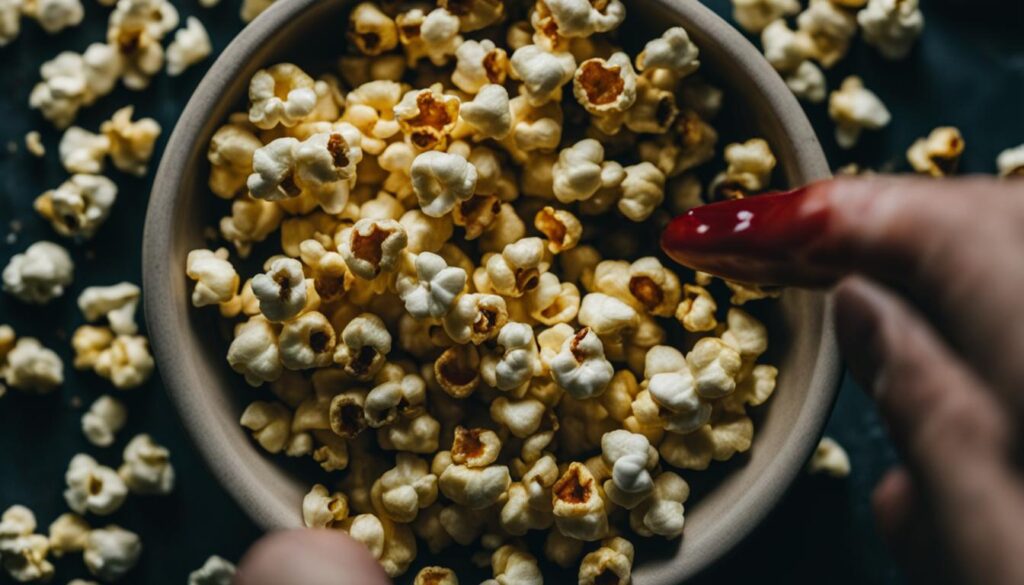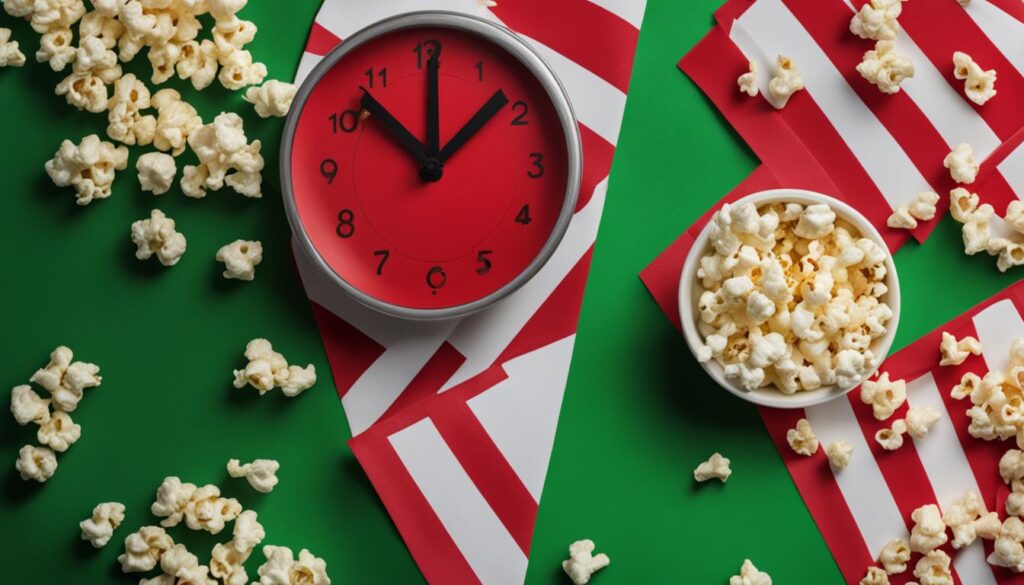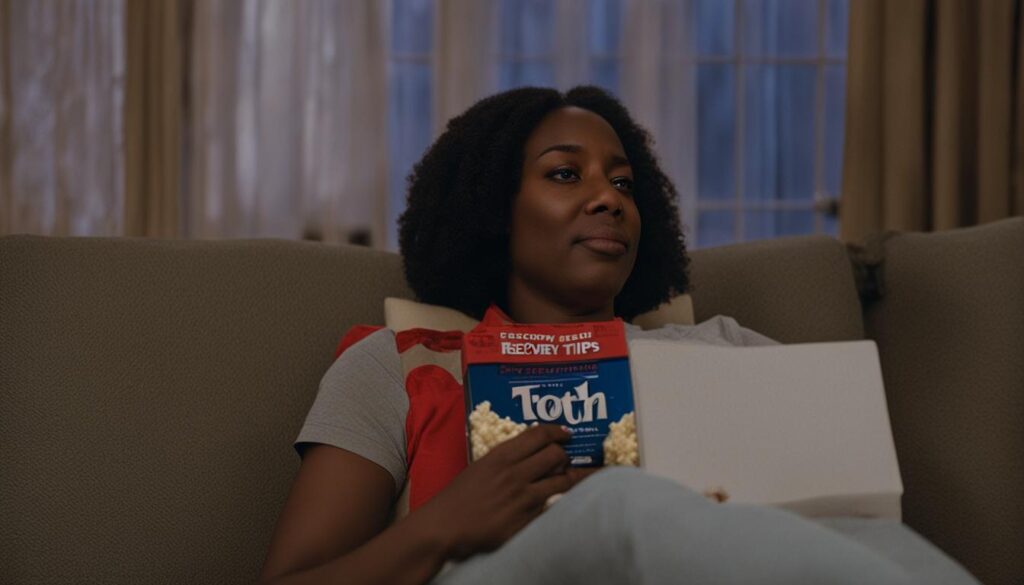After undergoing a tooth extraction, one of the common questions that arises is whether or not it is safe to eat popcorn. We’re here to provide you with the answer and guide you through the post-extraction diet for a smooth recovery.
When it comes to popcorn, it is generally not recommended to indulge in this crunchy treat immediately after a tooth extraction. The hard and chewy nature of popcorn kernels can pose several challenges during the healing process.
Popcorn kernels have the potential to get lodged in the empty socket, disrupting the formation of the blood clot. This can lead to complications such as delayed healing and a painful condition called dry socket. Therefore, it is advised to avoid crunchy or brittle foods, including popcorn, for a certain period of time post-extraction.
Instead, focus on incorporating soft foods into your diet that are easy to chew and do not pose a risk of causing any complications. These soft foods will provide necessary nutrition and aid in the healing process.
Key Takeaways:
- Avoid eating popcorn after tooth extraction due to its crunchy nature
- Popcorn kernels can get stuck in the empty socket and disrupt proper healing
- Follow a soft-food diet to promote optimal recovery
- Consult with your dentist regarding the recommended waiting period before reintroducing popcorn
- Patience and proper healing are crucial for a successful recovery
What Foods Can You Eat After Tooth Extraction?
After undergoing a tooth extraction, it’s crucial to follow a post-tooth extraction diet that consists of soft foods to promote proper healing and minimize discomfort. Here are some recommended foods that you can safely consume:
- Broth-based soups: These provide nourishment and are easy to consume without straining the extraction site.
- Mashed potatoes: Soft, creamy, and gentle on the healing gums.
- Pudding: A smooth and delightful treat that requires minimal chewing.
- Ice cream: Opt for a creamy and smooth variety without nuts or hard chunks.
- Smoothies: Blended fruits and vegetables provide essential nutrients and are easy to consume.
- Scrambled eggs: Soft and protein-rich, providing necessary energy for recovery.
- Cooked cereals: Thinned oatmeal or rice porridge are gentle on the healing gums.
- Pasta: Cooked pasta dishes, such as macaroni and cheese, are soft and easy to chew.
These soft food options are not only gentle on the healing gums but also provide important nutrients to support the healing process. Remember to avoid hard, crunchy, sticky, and acidic foods that can cause irritation and potentially delay the healing of the extraction site.
It’s important to consult with your dentist or oral surgeon for specific dietary guidelines and any limitations based on your individual case. Every situation is unique, and your dentist will provide personalized recommendations to ensure a smooth recovery from your tooth extraction procedure.
Foods to Avoid After Tooth Extraction

After undergoing a tooth extraction, it is important to be mindful of the foods you consume to promote proper healing and minimize the risk of complications. While it may be tempting to indulge in crunchy foods, such as popcorn, it is best to avoid them during the initial recovery period.
Can popcorn get stuck in the extraction area?
Yes, popcorn kernels have the potential to get lodged in the extraction site, causing irritation, inflammation, and potential infection. Additionally, the hard and sharp nature of popcorn kernels can disturb the formation of the blood clot, which is crucial for the healing process. Chewing on popcorn can also put pressure on the surgical area, increasing the risk of damage to the extraction site or stitches.
Therefore, it is essential to follow your dentist’s advice and opt for a soft-food diet that is gentle on the healing extraction site. This includes foods such as broth-based soups, mashed potatoes, yogurt, smoothies, and pudding. These foods provide necessary nutrients and are easy to chew, promoting a smooth recovery without compromising your oral health.
Risks of Eating Popcorn After an Extraction:
- Popcorn kernels can get stuck in the extraction site, causing irritation and potential infection.
- The hard and sharp nature of popcorn kernels can disturb the formation of the blood clot, delaying the healing process and increasing the risk of dry socket.
- Chewing on popcorn can put pressure on the surgical area, potentially causing damage to the extraction site or stitches.
By avoiding popcorn and other hard, crunchy foods, you will ensure a smoother and faster recovery after your tooth extraction. Remember, patience and proper healing are key to a successful recovery!
How Long Should You Wait Before Eating Popcorn?

After a tooth extraction, it is important to allow sufficient time for proper healing before considering eating popcorn. The time frame for consuming popcorn after a tooth extraction varies depending on factors such as the severity of the extraction and individual healing capabilities. It is generally recommended to wait at least 2-8 weeks before reintroducing crunchy and hard-to-chew foods like popcorn into your diet.
For wisdom tooth extraction specifically, the waiting period is typically around 7-14 days before consuming popcorn. This allows the extraction site to heal and reduces the risk of complications that may arise from chewing on harder foods too soon. It is essential to follow the guidance of your dentist, as they will provide personalized advice based on your specific situation.
During the waiting period, it is important to prioritize the healing process and focus on consuming soft foods that are easy to chew and do not pose a risk of causing irritation or complications. Following a post-tooth extraction diet consisting of foods like mashed potatoes, soups, pudding, and smoothies will help promote healing and ensure a smooth recovery.
Summary:
- Wait at least 2-8 weeks before eating popcorn after a tooth extraction.
- For wisdom tooth extraction, wait 7-14 days before consuming popcorn.
- Follow the guidance of your dentist for personalized advice.
- Focus on consuming soft foods that promote healing during the waiting period.
Alternatives to Popcorn After Tooth Extraction
After tooth extraction, it’s important to find alternative foods that are soft and easy to eat to aid in the healing process. Here are some alternatives to popcorn that you can enjoy while ensuring a smooth recovery:
- Applesauce: A smooth and gentle option that provides essential nutrients.
- Mashed Potatoes: Soft and creamy, mashed potatoes are easy to eat and can be flavored to your liking.
- Pudding: A delicious and comforting treat that requires minimal chewing.
- Yogurt: Smooth and creamy, yogurt is a great source of protein and probiotics.
- Cottage Cheese: Soft and gentle on the healing extraction site, cottage cheese provides a good source of protein.
- Smoothies: Blended fruits and vegetables are not only easy to consume but also packed with vitamins and minerals.
- Soups: Broth-based soups, such as chicken or vegetable, are nourishing and easy to eat.
- Oatmeal: Cooked oatmeal provides a warm, comforting meal that is easy to chew.
- Rice Pudding: A soft and creamy dessert that can be enjoyed without straining your healing extraction site.
- Ice Cream (without nuts or hard chunks): A cold and soothing treat that can help alleviate any discomfort.
Remember, it’s important to consult with your dentist for specific dietary instructions and to ensure you’re giving your mouth the proper care it needs during the recovery process. By opting for these soft and nutritious alternatives to popcorn, you can promote healing and make the recovery period more comfortable.
Tips for Proper Healing After Tooth Extraction

Proper healing after tooth extraction is essential for a smooth recovery and optimal oral health outcomes. Here are some tips to promote healing and minimize discomfort:
- Apply ice: Ice the mouth near the extraction site for the first 24 hours to reduce swelling and alleviate pain. Use an ice pack or wrap ice in a thin cloth and apply it in 15-minute intervals.
- Bite on damp gauze: After the extraction, bite down on damp gauze to control bleeding. Replace the gauze as needed, following the dentist’s instructions. Avoid using straws, as the suction can dislodge the blood clot.
- Stick to soft foods: During the initial healing phase, consume soft foods and liquids that do not require much chewing. This minimizes irritation to the extraction site and reduces the risk of complications. Incorporate foods like mashed potatoes, smoothies, and soups into your diet.
- Rinse gently: After eating, rinse your mouth gently with warm saltwater or a prescribed mouthwash to remove food debris and keep the extraction site clean. Avoid vigorous rinsing or using mouthwash during the first 24 hours.
- Follow post-operative care instructions: Each tooth extraction case is unique, so it’s crucial to follow the specific post-operative care instructions provided by your dentist. These instructions may include avoiding smoking, alcohol, and strenuous physical activity for a designated period.
Monitoring the extraction site
After tooth extraction, it’s important to keep an eye on the extraction site for any signs of infection or complications. If you experience severe pain, excessive bleeding, swelling, or pus formation, contact your dentist immediately. They can assess the situation and provide appropriate treatment if necessary.
The Importance of Patience and Proper Healing

When it comes to recovering from a tooth extraction, patience is key. While the temptation to indulge in crunchy snacks like popcorn may arise, it is crucial to wait for proper healing before reintroducing these foods into your diet. Rushing the healing process or neglecting post-extraction care instructions can lead to complications and prolonged discomfort.
Proper healing after tooth extraction takes time. It is essential to follow the recommended waiting period provided by your dentist before consuming hard or crunchy foods, including popcorn. This waiting period allows the extraction site to heal fully and reduces the risk of complications such as dry socket, delayed healing, and infection. By prioritizing patience and allowing your body to heal at its own pace, you promote optimal recovery and better oral health outcomes.
Benefits of Waiting for Proper Healing
- Minimizes the risk of complications
- Reduces the chance of developing dry socket
- Promotes complete healing of the extraction site
- Allows for the formation of a strong and healthy blood clot
- Helps prevent potential damage to the surgical site or stitches
By waiting for proper healing after tooth extraction, you give your body the time it needs to recover fully. It is crucial to follow the guidance of your dentist and refrain from consuming hard or crunchy foods, like popcorn, until you receive clearance. Remember, patience is a virtue when it comes to ensuring a successful and complication-free recovery after a tooth extraction.
Conclusion
In conclusion, it is important to prioritize your tooth extraction recovery by following a post-extraction diet and avoiding certain foods, including popcorn. While popcorn may be a tempting snack, its crunchy nature can pose risks to the healing process. Popcorn kernels can get stuck in the extraction site, disturb blood clot formation, and potentially lead to complications such as dry socket or infection.
Instead, focus on soft and easy-to-eat foods that promote proper healing and minimize discomfort during your recovery. Opt for options like mashed potatoes, soups, pudding, and yogurt. These foods are gentle on the extraction site and provide essential nutrients for your body to heal. Remember, a post-tooth extraction diet is an important part of your recovery plan.
By patiently following the recommendations of your dentist and maintaining proper oral hygiene, you can ensure a smooth recovery and better oral health outcomes. Allow your extraction site to fully heal before reintroducing crunchy foods like popcorn back into your diet. Your patience and commitment to a post-tooth extraction diet will pay off in the long run, resulting in a faster recovery and a healthier smile.
If you have any concerns or questions about your tooth extraction recovery or post-extraction diet, always consult with your dentist. They will provide personalized advice and guidance based on your specific circumstances, ensuring the best possible outcome for your oral health.
FAQ
Can I eat popcorn after tooth extraction?
After tooth extraction, it is generally not recommended to eat popcorn due to its crunchy and hard-to-chew nature. Popcorn kernels can easily get stuck in the empty socket, disturb the blood clot formation, and delay the healing process. Specialists recommend avoiding crunchy or brittle foods, including popcorn, for at least 2-8 weeks post-extraction, depending on the severity of the extraction.
What foods can I eat after tooth extraction?
It is important to consume soft and easy-to-eat foods that do not require much chewing to avoid irritating the extraction site and promote proper healing. Some recommended foods include broth-based soups, mashed potatoes, pudding, ice cream, smoothies, scrambled eggs, cooked cereals, thinned oatmeal, and pasta.
What are the risks of eating popcorn after tooth extraction?
Eating popcorn too soon after tooth extraction can pose various risks and complications. Popcorn kernels have the potential to get stuck in the extraction site, causing irritation, inflammation, and potential infection. The hard and sharp nature of popcorn kernels can also disturb the blood clot formation, delay the healing process, and increase the risk of developing dry socket.
How long should I wait before eating popcorn after a tooth extraction?
The recommended waiting period before eating popcorn after a tooth extraction varies depending on the severity of the extraction and the dentist’s instructions. In general, it is advised to wait at least 2-8 weeks after tooth extraction before considering eating popcorn or any other hard or crunchy foods. For wisdom tooth extraction specifically, it is recommended to wait 7-14 days for the extraction site to fully heal before consuming popcorn.
What are some alternatives to popcorn after tooth extraction?
Instead of popcorn, there are plenty of soft and nutritious alternatives that can be consumed after tooth extraction. These include applesauce, mashed potatoes, pudding, yogurt, cottage cheese, smoothies, soups, oatmeal, rice pudding, and ice cream (without nuts or hard chunks).
What are some tips for proper healing after tooth extraction?
To ensure proper healing after tooth extraction, it is important to follow certain tips and practices. These include icing the mouth near the extraction site for the first 24 hours, biting on damp gauze to control bleeding, avoiding using straws, consuming soft foods and liquids, rinsing the mouth after eating, and maintaining good oral hygiene.
Why is patience and proper healing important after tooth extraction?
Patience and proper healing are crucial after tooth extraction to ensure a successful recovery. Rushing the healing process or ignoring aftercare instructions can lead to complications such as dry socket, delayed healing, infection, and prolonged discomfort.

Leave a Reply